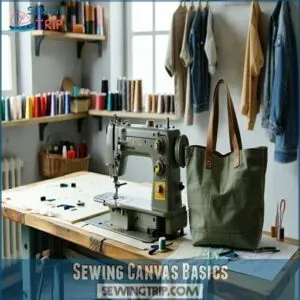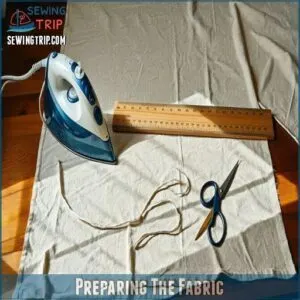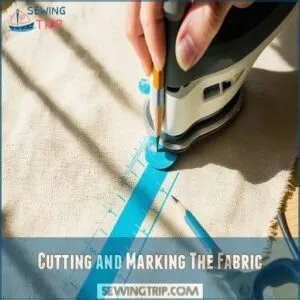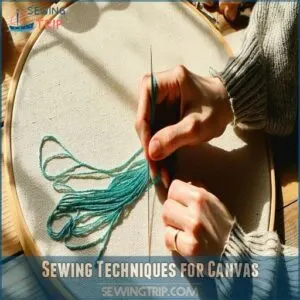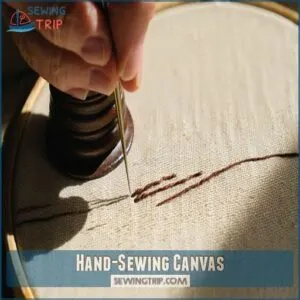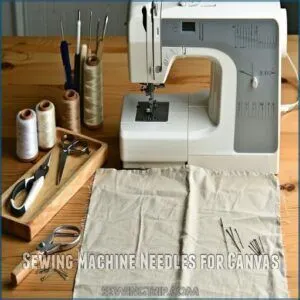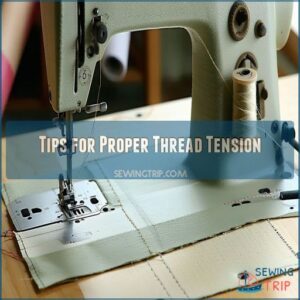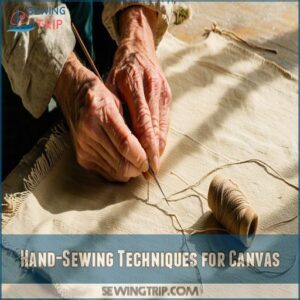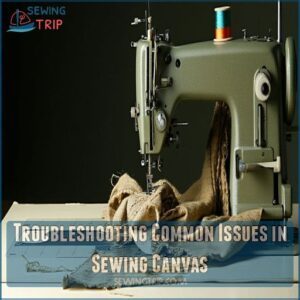This site is supported by our readers. We may earn a commission, at no cost to you, if you purchase through links.

A walking foot for your sewing machine will prevent the fabric from shifting as you sew.
Set your stitch length to 4-5mm. Sew slowly and steadily, reinforcing seams with backstitching for extra durability.
Like taming a wild horse, mastering canvas takes patience, but these tricks of the trade will make your projects virtually indestructible.
Table Of Contents
- Key Takeaways
- Sewing Canvas Basics
- Step-by-Step Guide: How to Sew Canvas
- Sewing Machine Needles for Canvas
- Thread Options for Sewing Canvas
- Finishing Techniques for Sewing Canvas
- Hand-Sewing Techniques for Canvas
- Choosing The Right Sewing Machine for Canvas Projects
- Creative Canvas Projects to Sew
- Tips for Sewing Different Types of Fabric
- Troubleshooting Common Issues in Sewing Canvas
- Frequently Asked Questions (FAQs)
- Conclusion
Key Takeaways
- You’ll need size 90/14 or 100/16 needles and heavy-duty polyester thread to effectively sew canvas, as regular needles and thread will break under the material’s thickness.
- Your sewing machine requires specific adjustments – set the stitch length to 4-5mm, slow down your speed, and use a walking foot to prevent fabric bunching and shifting.
- You should reinforce all seams with backstitching and consider adding interfacing at stress points, especially for bags, outdoor gear, and heavy-use items.
- You can tackle canvas projects on a regular sewing machine by matching your thread weight to fabric thickness, maintaining consistent tension, and using proper needles – but take it slow and test settings on scrap pieces first.
Sewing Canvas Basics
You’ll master canvas sewing faster than you think when you start with the right tools and techniques, including a heavy-duty needle and strong thread.
Whether you’re creating a stylish tote bag or tackling outdoor gear, you’ll find that working with canvas isn’t as tough as it seems once you’ve got the basics down.
What is Canvas Material?
Canvas material is like the heavyweight champion of fabrics – it’s a tightly woven, ultra-durable textile that’s tough enough to handle almost anything you throw at it. Whether you’re diving into DIY projects or crafting professional pieces, understanding canvas fabric properties is key to your success.
Canvas comes in different weights and styles, ranging from lightweight duck canvas to heavy-duty sailcloth. What makes it special is its unique construction of interlaced cotton or synthetic fibers that create a distinctive diagonal weave pattern.
Here’s what makes canvas stand out:
- Its remarkable durability factors include resistance to tears, punctures, and general wear
- The fabric’s natural breathability makes it perfect for outdoor gear and fashion items
- Different canvas types offer varying weights, from 7 ounces to over 20 ounces per square yard
Choose your canvas weight based on your project needs – lighter for accessories, heavier for upholstery or outdoor items.
Essential Tools for Sewing Canvas
Before diving into your canvas project, you’ll need some essential canvas sewing tools to tackle this sturdy fabric. Understanding what are sewing canvas is important for selecting the right tools and techniques for your project.
Stock up on sharp cutting tools like rotary cutters and heavy-duty scissors for clean edges.
For your sewing machine, you’ll want canvas needles (size 90/14 or 100/16) and a walking foot. Replace traditional pins with fabric clips to hold layers together without damage.
Don’t forget a seam ripper and measuring tools for precise work.
For hand sewing tools for canvas, grab a thimble and leather needle – your fingers will thank you later.
Choosing The Right Thread for Canvas
Pick a thread that’s as tough as the canvas itself. Match the thread type to your needle, and don’t skimp on quality—weak thread will unravel faster than your sewing patience!
A heavy-duty polyester or nylon thread works best, offering UV resistance and colorfastness. Topstitching thread adds a polished touch, while proper canvas thread weight guarantees durability.
Can You Use a Regular Sewing Machine?
Yes, your regular sewing machine can sew canvas, but it needs the right setup.
Start with a heavyweight needle (90/14 or 100/16) and strong polyester thread—this combo handles canvas beautifully.
Adjust stitch settings and presser foot pressure to keep from skipping stitches. Go slow, clean lint often, and don’t rush the process.
With proper needle selection and stitch adjustments, your sewing machine is ready for your next canvas project!
Tips for Sewing Canvas Seamlessly
When tackling canvas, slowing down and focusing on smooth, consistent stitches will make a world of difference. Strong seams need the right tools and techniques—perfect your craft with these sewing canvas tips:
- Use heavy-duty needles like size 90/14 or 100/16 to handle thick fabric.
- Invest in strong thread, such as polyester or nylon.
- Topstitch for added seam strength and durability.
- Increase stitch length to prevent canvas tension issues.
- Avoid bunching by using a walking foot.
Finishing Touches for Canvas Projects
Want your canvas projects to look polished and last longer? Focus on these finishing touches:
- Use zigzag stitching or serging for neat edge sealing and fray prevention.
- Reinforce seams and stress points with bar tacking for extra durability.
- Add hardware like rivets or grommets for style and function.
Finish with protective coatings for added fabric protection and easy stain removal, keeping your creations sturdy and stylish.
Step-by-Step Guide: How to Sew Canvas
Sewing canvas might seem tricky, but with the right steps, it’s totally doable.
From prepping the fabric to choosing the perfect stitch, you’ll learn everything you need to create strong, polished projects.
Preparing The Fabric
Getting your canvas fabric prepped sets you up for a smooth sewing journey. Pre-wash the fabric to handle shrinkage head-on and ditch any coatings.
Then iron it flat—think crisp, not scorched. Pay attention to the grain direction while cutting for accuracy.
Having the right sewing kit can make a significant difference in your project’s outcome. Here’s a quick prep guide:
| Task | Why it Matters | Pro Tip |
|---|---|---|
| Pre-wash necessity | Stops shrink shock | Use cold water, gentle cycle |
| Ironing techniques | Smooths wrinkles | Use steam for stubborn creases |
| Grain direction | Guarantees stability | Align cuts with fabric threads |
Cutting and Marking The Fabric
Precision is key when working with canvas fabric for sewing.
Use a rotary cutter or sharp sewing scissors for accurate cuts—dull scissors won’t cut it, literally!
Marking tools like tailor’s chalk or disappearing ink help keep lines clean.
Folding techniques can improve alignment, while careful canvas measurement guarantees success.
For the best cutting tools can substantially enhance the sewing experience.
These fabric cutting tips save time and prevent wasted material, utilizing sharp sewing scissors and disappearing ink.
Sewing Techniques for Canvas
Tackling canvas stitching takes patience and the right moves.
On your machine, increase stitch length to 4-5mm and prep for fabric tension adjustments. Use a walking foot to prevent bunching and backstitch to reinforce seams.
For sewing heavy canvas by hand, grab a sturdy needle and waxed thread, and let a thimble save your fingers! Understanding sewing canvas basics is essential for a successful project.
Ready to explore stitches? Here’s a quick guide:
| Stitch Type | Purpose | Expert Tip |
|---|---|---|
| Straight | Basic seams | Longer stitches for durability |
| Zigzag | Preventing fraying | Wide for strong raw edge binding |
| Blind Hem | Invisible edges | Add interfacing for precision |
| Buttonhole | Durable closures | Stabilize with interfacing |
| Bar Tack | Stress points | Maximize strength on corners |
| Decorative | Stylish flair | Add flair while reinforcing seams |
Hand-Sewing Canvas
While machine stitching speeds through canvas, hand sewing lets you master every detail of your project. Start by selecting a sharp upholstery needle and waxed polyester thread – they’ll power through thick fabric without breaking. You’ll want a metal thimble to protect your fingers (trust me, canvas can be stubborn). Having a complete sewing kit is essential for any canvas project.
Secure your canvas in an embroidery hoop to keep it steady. This old-school technique prevents puckering and helps you nail those even stitches. Work in small sections, keeping your thread length at arm’s reach to avoid tangles.
For the cleanest hand sewing canvas results, use a backstitch – it’s like building a brick wall, each stitch overlapping the last. Keep your tension consistent but not too tight. Your stitches should lie flat against the fabric, creating a durable seam that’ll last for years.
Choosing The Best Stitch for Canvas
When sewing canvas, your stitch selection makes a huge difference in project durability.
For straight seams, use a longer straight stitch (3.0-4.0mm) to prevent tearing the fabric.
You’ll want to adjust your thread tension and sewing speed based on canvas thickness.
A zigzag stitch works great for edges, while a triple straight stitch adds extra strength to high-stress areas that need fabric stability.
To achieve professional results, consider investing in sewing machines specifically designed for canvas.
Sewing Machine Needles for Canvas
You’ll need the right needle to tame that tough canvas fabric, just like you wouldn’t use a butter knife to slice through a thick steak.
Whether you’re working with lightweight duck canvas or heavy-duty sailcloth, choosing the correct needle size and type will make the difference between smooth sailing and a frustrating sewing experience.
Understanding Needle Sizes for Canvas
Picking the right needle size can make or break your canvas project. Let’s get you sorted with the perfect match for your fabric. The heavier your canvas, the bigger the needle you’ll need – it’s like choosing the right tool for the job.
- Size 90/14 needles work great for basic canvas projects
- Bump up to 100/16 for heavy-duty canvas and multiple layers
- Thread tension needs adjusting as you go up in needle size
- Slower sewing speed with bigger needles prevents breakage
- Check your fabric density to determine ideal needle size
Remember, canvas thickness varies widely, so test your needle on a scrap piece first. Your sewing machine will thank you!
Types of Needles for Sewing Canvas
The right needle makes all the difference when tackling canvas projects.
You’ll want to reach for sharp needles specifically designed for heavy-duty fabrics.
Denim needles work wonders with their reinforced shafts and extra-sharp points – they’ll power through multiple layers of canvas like butter.
For best results, grab some Schmetz or Organ brand needles in sizes 90/14 to 110/18.
Don’t forget about leather needles too – they’re surprisingly great for canvas stitching.
These specialized needles prevent skipped stitches and minimize wear on your machine.
Tips for Needle Selection and Replacement
Many sewists overlook how vital proper needle selection is for canvas projects. Your sewing speed and thread tension depend on choosing the best canvas needles for your machine.
Here’s what to watch for:
- Replace needles every 4-6 hours of heavy-duty sewing
- Match needle size to fabric thickness (size 100/16 for heavy canvas)
- Choose titanium-coated needles for longer life
- Check needle alignment before each project
Understanding the difference between serger needles is also essential for ideal results in various sewing tasks. Remember to consult your machine’s manual for compatible canvas needle sizes and types. When in doubt, start with a fresh needle.
Thread Options for Sewing Canvas
You’ll want to pick the right thread for your canvas project, just like choosing the perfect running shoes for a marathon.
Whether you’re working with lightweight duck canvas or heavy-duty sailcloth, your thread choice can make the difference between a project that lasts for years and one that falls apart at the seams.
Choosing The Right Thread Weight for Canvas
Selecting thread weight for canvas is like choosing the right rope for climbing – you need something that won’t let you down.
Let’s pair your heavy-duty needles with the perfect thread weight.
For canvas sewing success, match your thread weight to your fabric’s thickness.
| Thread Weight | Best Uses | Fabric Weight | Needle Size | Tension Setting |
|---|---|---|---|---|
| #30 | Light Canvas | 8-10 oz | 90/14 | 4-5 |
| #24 | Medium Canvas | 10-12 oz | 100/16 | 5-6 |
| #20 | Heavy Canvas | 12-15 oz | 110/18 | 6-7 |
| #16 | Extra Heavy | 15-20 oz | 120/20 | 7-8 |
| #12 | Industrial | 20+ oz | 130/21 | 8-9 |
Polyester Vs. Nylon Thread for Canvas
The battle between polyester and nylon thread for canvas sewing comes down to raw strength and performance. You’ll want polyester thread as your go-to choice for most canvas projects.
- Polyester maintains consistent tension through thick materials
- It resists fading and damage from sun exposure
- The thread keeps its shape without stretching out
- It holds strong even in wet conditions
For superior sewing performance, grab V-69 polyester thread – it’ll power through canvas like butter while nylon might snap under pressure.
Benefits of Heavy-Duty Thread for Canvas
While polyester and nylon have their merits, heavy-duty thread transforms your canvas projects into long-lasting masterpieces.
Here’s why serious sewers swear by it:
| Feature | Benefit | Real-World Impact |
|---|---|---|
| Thread Strength | Resists pulling and wear | Your beach tote stays intact all summer |
| UV Protection | Prevents sun damage | Outdoor cushions keep their stitching |
| High Thread Count | Creates durable seams | Camping gear handles rough terrain |
You’ll notice the difference immediately – stronger seams, cleaner stitches, and canvas projects that laugh in the face of heavy use.
Tips for Proper Thread Tension
Setting perfect thread tension for canvas can feel like cracking a secret code, but don’t worry – it’s simpler than you think.
Start by adjusting your machine’s tension control between 4-6, then test on a scrap piece. You’ll know you’ve nailed it when your stitches look identical on both sides.
For heavyweight canvas, bump up your tension slightly and use a longer stitch length (3-4mm). If threads loop or bunch underneath, decrease the upper tension. If the stitches pull too tight, loosen it up gradually until they lay flat.
Finishing Techniques for Sewing Canvas
You’ll love how the right finishing touches transform your canvas projects from homemade to professional-looking, whether you’re adding crisp seam finishes or sturdy fasteners.
With a few simple techniques up your sleeve, you can create canvas items that’ll make your friends wonder if you’ve secretly become a master craftsperson.
Seam Finishes for Canvas
Now that you’ve got your thread sorted, let’s make those seams look pro-level.
Start with a clean edge using canvas overlock or seam binding – this stops fraying before it starts.
For extra strength, reinforce your stitch lines with a tight zigzag stitch pattern.
French seams work wonders on lighter canvas, while flat fell seams give heavy-duty projects that rugged, industrial look.
Remember, overlapping seams need fabric interfacing to prevent bulk and maintain shape.
Hemming Methods for Canvas
After mastering those seam finishes, you’ll want to tackle canvas hemming – it’s like giving your project a polished signature. Start with a basic folded hem technique: press your canvas edge up 1/2 inch, then fold it again and stitch close to the inner fold. For heavyweight canvas, try a flat fell hem – it’s sturdy and lies smooth against your project.
Your sewing machine needles need to be up for the task, so opt for size 100/16 or larger. When working with heavy duty canvas, consider a double-fold hem with a 1-inch seam allowance for extra stability. For rolled edges that’ll stand up to wear, use a rolled hem foot on your machine – it’ll create neat, professional-looking results every time.
Looking to add some flair? Decorative topstitching along your hems can make them both stronger and more stylish.
Adding Fasteners to Canvas Projects
Fasteners transform your canvas projects from basic to brilliant, giving them that professional edge you’re after.
Let’s explore your best options for securing your work:
- Install rivets at stress points for rugged durability – perfect for heavy-duty canvas bags
- Add grommets in different sizes for ventilation or drawstring features
- Choose snap fasteners for easy-access closures that won’t fray
- Pick sturdy buckles that complement your canvas weight
- Place eyelets strategically for lacing or decorative elements
Remember to reinforce these areas with extra layers of canvas to prevent tear-outs.
Your sewing machine can handle most installations with the right heavy-duty thread and careful technique.
Hand-Sewing Techniques for Canvas
You’ll be amazed at how a sturdy needle and the right hand-sewing techniques can transform your canvas projects into professional-looking creations.
While your sewing machine might be taking a break, you’ll learn the time-tested methods that sailors and craftspeople have used for centuries to create strong, lasting stitches in canvas by hand.
Best Stitches for Hand-Sewing Canvas
Hand-sewing canvas opens up a world of creative possibilities, and mastering the right stitches makes all the difference. Let’s explore the most effective stitches that’ll give your projects that professional touch.
Understanding hand sewing techniques is essential for achieving high-quality results in canvas sewing.
| Stitch Type | Best For | Difficulty | Durability | Tips |
|---|---|---|---|---|
| Running Stitch | Quick seams | Easy | Moderate | Keep stitches small |
| Backstitch | Strong seams | Medium | High | Double thread it |
| Saddle Stitch | Heavy duty | Hard | Very high | Use waxed thread |
| Blanket Stitch | Edges | Medium | High | Space evenly |
| Loop Stitch | Reinforcement | Easy | Moderate | Pull firmly |
You’ll want to maintain consistent stitch tension throughout your work. Start with the running stitch to get comfortable with canvas threads, then progress to more complex techniques like the backstitch for durability. Remember, smaller stitches generally mean stronger seams – think of it as building a brick wall, where each stitch is a carefully placed brick.
Tools and Accessories for Hand-Sewing Canvas
Getting your hands on the right tools makes canvas hand sewing feel like a breeze instead of a battle. You’ll want to grab these game-changing items for your sewing kit:
- Heavy-duty thimbles – Go for leather or metal thimbles to shield your fingers when pushing those thick needles through canvas. They’re lifesavers for long sewing sessions.
- Extra-long upholstery needles – Look for 2-3 inch needles that slice through canvas like butter. The longer length gives you better control and saves your hands from strain.
- Sharp sewing awls – These handy tools pre-punch holes in thick fabric, making your stitching smoother and faster. Plus, they’re perfect for marking your sewing lines.
- Needle holders – Keep your needles organized and prevent painful surprises with a magnetic holder or traditional needle case.
- Quality fabric cutters – Sharp scissors or rotary cutters designed for heavy fabrics will give you clean, precise cuts without fraying or struggling.
Investing in the right sewing accessories, such as those found at sewing accessories, can greatly enhance your sewing experience.
Remember to store these tools in a dedicated hand sewing kit, keeping everything organized and ready for your next canvas project.
Tips for Durability and Strength in Hand-Sewn Canvas Projects
While canvas sewing techniques demand precision, you’ll achieve rock-solid results by preparing your fabric and tools thoughtfully. Don’t skip fabric preparation; pre-wax your thread and use a thimble to protect your fingers.
Start with proper canvas reinforcement at stress points using a double strand of heavy-duty thread. For stitch selection, opt for a tight backstitch or lock stitch that’ll hold up to wear and tear.
Choose specialized canvas thread and needle combinations – think size 3 thread with a sturdy leather needle. Understanding what are sewing canvas materials is essential for successful projects.
When hand sewing canvas, maintain consistent tension and overlap your stitches by at least 1/4 inch.
Choosing The Right Sewing Machine for Canvas Projects
You’ll need a machine with some muscle to tackle canvas projects, and today we’ll help you find the perfect workhorse for your heavy-duty sewing needs.
Whether you’re planning to make sturdy tote bags or outdoor gear, choosing a sewing machine with the right features will make the difference between smooth sailing and frustrating thread breaks.
Features to Consider in a Sewing Machine for Canvas
Your canvas journey needs a workhorse sewing machine that won’t break a sweat. Look for strong metal frames and powerful motors that’ll power through multiple layers effortlessly. Don’t forget to test the motor power on scrap fabric first – it’ll save you headaches later.
Check that your machine offers adjustable presser foot types and varying stitch length options – you’ll need this flexibility for different canvas weights.
Feed dog strength matters too; it should grip firmly without marking your fabric.
Regarding the needle system, confirm your machine accepts size 100/16 or 110/18 needles for heavy-duty sewing canvas.
Top Sewing Machine Recommendations for Sewing Canvas
After checking those machine features, let’s look at the top performers for canvas work in 2024. The Janome 2212 leads the pack with its impressive 2,000-stitch-per-minute speed and versatile stitch options.
For home sewists, consider these proven winners:
- Brother CS-5000i shines with its 25-year warranty and 50 built-in stitches
- Singer 4423 offers industrial strength at a budget-friendly price point
- Juki HZL-MX5 dominates heavy-duty projects with 5,000 stitches per minute
Each machine handles canvas fabric like a champ, but matches different needs and budgets. Remember to pair yours with heavy-duty needles for best results.
Creative Canvas Projects to Sew
You’ll be amazed at how many creative projects you can tackle with canvas, from sturdy tote bags and stylish backpacks to custom upholstery and outdoor gear.
Whether you’re looking to craft your first camping hammock or transform your living room with handmade throw pillows, you’ll find that canvas is the perfect material for bringing your ideas to life.
Tote Bags and Backpacks
Creating canvas bags isn’t just a craft – it’s your gateway to making stunning, practical accessories that’ll last for years. Start with a simple market tote to master canvas durability and basic bag design.
When choosing strap options, opt for double-layered canvas with reinforced stitching at stress points. Your project patterns should include interior pockets and sturdy hardware choices like metal D-rings.
For a professional canvas bag tutorial finish, add interfacing to maintain shape, then double-stitch all seams. Remember to test your tote bag sewing with actual items to confirm it holds up to daily use.
Upholstery and Home Decor
While tote bags showcase canvas’s portability, your home deserves the same durable charm. Transform your living space with canvas upholstery projects that blend style and strength.
Start with simple cushion covers and canvas pillows, then work your way up to sophisticated slipcovers for indoor furniture.
You’ll love how canvas’s natural texture adds depth to your DIY sewing projects – from sleek table runners to statement wall hangings.
Think outside the box: craft unique decorative accents like canvas-wrapped frames or bold geometric art pieces. With the right techniques, you’ll turn basic upholstery fabric into showstopping home decor.
Outdoor Gear and Accessories
Canvas lets you craft gear that laughs in the face of mother nature, from rugged weatherproof backpacks to durable tent repairs. You’ll discover endless possibilities for outdoor canvas projects – think custom camp chair upholstery, tool rolls, and equipment covers.
Start with heavy-duty thread and reinforced seams for maximum durability. Your sewing machine might groan at first, but take it slow over thick spots and you’ll master canvas gear maintenance in no time.
Plus, customizing your own outdoor gear saves money while freeing your creativity.
Clothing and Accessories
Canvas is perfect for crafting stunning fashion pieces, moving beyond outdoor gear. You can transform this versatile fabric into everything from rugged shoes to chic tote bags.
Want to make durable canvas wallets or trendy canvas backpacks? Start with garment-weight canvas for a more wearable finish.
Add embroidered canvas patches for a personal touch, or create statement pieces like structured jackets. Remember to adjust your machine settings for thicker materials, and don’t forget proper canvas garment care to keep your creations looking fresh for years.
Tips for Sewing Different Types of Fabric
Each type of canvas fabric has its own personality, from lightweight duck canvas perfect for tote bags to heavyweight options that challenge even the toughest needles.
You’ll need to adjust your sewing techniques and tools to match the fabric’s weight and weave, whether you’re working with traditional cotton canvas or modern blended varieties.
Lightweight Canvas Vs. Heavyweight Canvas
Understanding canvas weight is essential when you’re diving into canvas sewing projects.
Lightweight canvas (around 7-9 oz) offers better drapability and is perfect for clothing, totes, and indoor items. You’ll find it’s easier to maneuver through your machine and more budget-friendly.
Heavyweight canvas (10-24 oz) delivers superior durability for outdoor gear and furniture but requires heavy canvas needles and specialized thread.
Consider your project’s demands – if you’re making a delicate summer dress, lightweight canvas is your friend, while a boat cover calls for heavyweight’s rugged strength.
Blended Canvas Fabrics
Blended canvas fabrics offer you the best of both worlds, combining natural and synthetic fibers for enhanced durability and versatility. When you’re sewing canvas, these blends can make your projects more forgiving and long-lasting.
- Cotton-polyester blends provide excellent shrinkage control and strength
- Nylon-cotton mixes offer superior water resistance
- Rayon blends create softer, more breathable canvas
- Spandex combinations add stretch and flexibility
- Linen-cotton blends maintain structure while improving drape
These fabric blend ratios typically range from 40/60 to 65/35, giving you options for every project with enhanced durability and natural fibers.
Specialty Canvas Fabrics
Step into the field of specialty canvas fabrics, where waterproof canvas sewing opens up endless possibilities. From marine-grade canvas to water-resistant canvas, each variety offers unique characteristics for your projects.
| Canvas Type | Best Uses | Key Features | Required Tools | Care Tips |
|---|---|---|---|---|
| Heavy-duty Canvas | Outdoor gear | Robust weave | #16 needle | Spot clean |
| Marine-grade | Boat covers | Waterproof | Heavy thread | Air dry |
| Canvas clothing | Workwear | Breathable | Walking foot | Machine wash |
| Water-resistant | Bags | Coated finish | Teflon foot | Gentle cycle |
| Treated canvas | Upholstery | Stain-proof | Leather needle | Professional clean |
Choose fabric treatments and coating options that match your project’s needs for durability and style.
Troubleshooting Common Issues in Sewing Canvas
You’ll find that even experienced sewists run into canvas-related mishaps, from broken needles to skipped stitches that look like your machine had a bad day.
Don’t worry though – we’ll walk you through the most common canvas sewing problems and show you exactly how to fix them, so you can get back to creating your masterpiece.
Thread Breakage and Tension Problems
Thread tension troubles can turn your canvas project into a frustrating mess of broken threads and uneven stitches. When your thread keeps snapping, here’s your game plan:
- Check your thread quality – old or weak thread is prone to breakage from fabric friction
- Adjust bobbin tension gradually – too tight means trouble
- Slow down your sewing speed – rushing through thick canvas invites problems
- Use the right thread weight – opt for strong polyester thread designed for canvas sewing
Keep your sewing speed steady and moderate. Think of canvas like a tough workout partner – it needs the right equipment and proper form to work with you, not against you.
Needle Breakage and Dullness
Battling with broken needles while tackling canvas projects? Your needle selection makes all the difference.
Switch to a heavyweight denim needle (90/16 or 110/18) designed specifically for canvas fabric. These powerhouses feature reinforced shafts and ultra-sharp points that slice through multiple layers without breaking a sweat.
Keep an eye on signs of dullness – if you’re hearing a ‘popping’ sound or seeing irregular stitches, it’s time for a fresh needle. Pro tip: extend your needle life by changing it every 6-8 hours of sewing time, and always use a heavyduty needle that matches your canvas weight.
Uneven Seams and Skipped Stitches
Frustrating skipped stitches can turn your canvas masterpiece into a messy disaster. To fix those pesky uneven seams, start by swapping to a heavy-duty 100/16 needle designed for canvas.
Keep your thread tension balanced – if it’s too tight or loose, you’ll see gaps. When sewing canvas, slower speeds prevent fabric slippage and maintain perfect seam alignment.
Clean your machine’s feed dogs regularly and oil moving parts to guarantee smooth stitching. Most importantly, test your stitch length on scrap fabric before diving into your project.
Tips for Preventing and Resolving Issues in Sewing Canvas
Those skipped stitches in your canvas project can turn into a headache fast. Here’s how to keep your canvas sewing smooth and error-free:
- Check your thread tension and presser foot pressure before starting – they’re like the steering wheel and gas pedal of your sewing machine
- Clean out lint buildup weekly and oil moving parts monthly for peak performance
- Practice on scrap canvas pieces to nail down the right settings and prevent fabric distortion
Remember, even pros hit snags sometimes – it’s all part of mastering canvas sewing.
Frequently Asked Questions (FAQs)
Can you sew canvas with a sewing machine?
Yes, you’ll open up a world of sewing possibilities! Your machine can handle canvas with the right heavy-duty needle (90/14 or 100/16) and strong thread. Just adjust your settings and sew slowly.
How to cut the canvas for a sew-on patch?
Use sharp fabric scissors to cut your patch shape with a 1/4-inch seam allowance.
Iron fusible interfacing to the back, then trim edges clean.
You’ll need precise cuts for professional results.
How do you sew canvas?
Like taming a wild stallion, you’ll need heavy-duty needles and thread.
Start with straight stitches, using a walking foot to guide thick fabric.
Keep tension balanced and stitch slowly for best control.
Should you learn to sew canvas?
Learning to sew canvas opens up endless creative possibilities for making durable bags, outdoor gear, and home decor.
If you’re ready to tackle tougher fabrics and create lasting items, it’s definitely worth your time.
Can I sew canvas with a regular sewing machine?
Yes, you can sew canvas with a regular sewing machine, but you’ll need a heavy-duty needle (size 90/14 or 100/16) and strong polyester thread.
Take it slow and adjust your machine’s tension accordingly.
Is canvas difficult to sew?
Picture zipping through denim jackets on your machine – canvas isn’t much different.
While it’s thicker than regular fabric, you’ll find it’s manageable with the right needle and proper technique.
It’s not difficult, just different.
Do you need a special needle to sew canvas?
You’ll definitely need a denim or heavy-duty needle (sizes 90/14 or 100/16) to tackle canvas. Regular needles won’t cut it – they’ll break or struggle with the thick material, leaving you frustrated.
What type of thread to sew canvas?
For canvas projects, you’ll want heavy-duty polyester or bonded nylon thread; they’re tough enough to handle the thick fabric.
Aim for size 40-69 weight thread, and don’t skimp on quality here.
Can I sew canvas with regular cotton thread?
Regular cotton thread isn’t strong enough for canvas – it’ll snap under tension.
Heavy-duty polyester or nylon threads designed for thick fabrics are more durable and won’t break during sewing.
What temperature should I iron canvas fabric?
While 90% of sewists struggle with canvas ironing temperatures, you’ll get the best results using medium-high heat (around 300°F/150°C).
Test on a small area first, and use a pressing cloth to prevent scorching.
Conclusion
There you have it – you’re now equipped with pro tips on how to sew canvas like a seasoned craftsperson.
Whether you’re tackling a simple tote bag or diving into complex upholstery projects, remember that patience and proper tools are your best friends.
Don’t let the thick fabric intimidate you – with the right needle, thread, and machine settings, you’ll be amazed at what you can create.
Keep practicing, and soon you’ll be sharing your own tricks for how to sew canvas with fellow makers.

